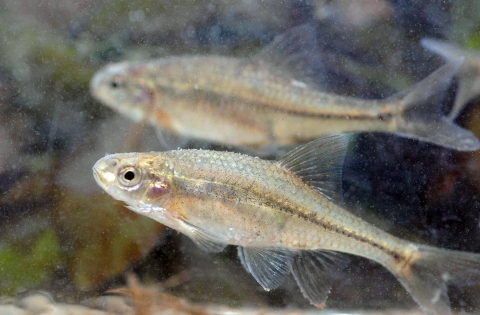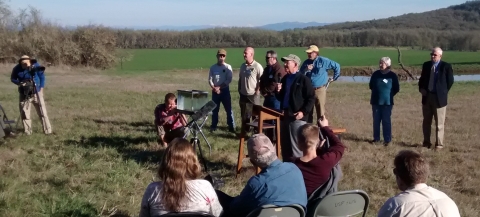EDITOR'S NOTE: 2023 marks the golden anniversary of the ESA, a law that has been a powerful catalyst for conservation of America’s most treasured fish, wildlife, plants and their habitats for five decades. People power the mission of the U.S. Fish and Wildlife Service. Here in the Pacific Region, Tribal, federal and state partners, local supporters, and our dedicated staff are the driving force behind the successes we share and the strength ensuring we can continue to face the challenges ahead. Throughout this year-long celebration, we invite you to celebrate this milestone with us as we reflect on past successes, assess current challenges, and envision an equally bright future for the next 50 years and beyond.
This article was originally published on Feb. 17, 2015, to announce the recovery of the Oregon chub, the first fish ever removed from the federal list of endangered and threatened animals.
The Oregon chub may be a small fish, but it made huge waves as it became the first fish ever removed from the federal list of endangered and threatened animals due to recovery.
U.S. Fish and Wildlife Service (Service) made the historic announcement on Feb. 17, 2015, at an event at the William L. Finley National Wildlife Refuge in Corvallis, Oregon, attended by Rep. Peter DeFazio of Oregon, Curt Melcher, director of the Oregon Department of Fish and Wildlife, and representatives of many other partners groups that were central to recovery of the chub.
“This milestone demonstrates how the Endangered Species Act can bring people together to accomplish a shared goal,” said Secretary of the Interior Sally Jewell. “This effort succeeded because of an extraordinary partnership between federal and state agencies, landowners and other stakeholders who brought this species and ecosystem back from the brink of extinction in just over 20 years. We’re now managing the river in a smarter way, which means better opportunities for recreation, a boost for salmon recovery and improved water quality – all of which are good news for Oregon and its economy.”
Melcher celebrated the announcement, proud that the first fish to recover after being listed under the Endangered Species Act is a species unique to Oregon.
“The Oregon chub is the first fish in the nation to be recovered under the Endangered Species Act because of the sustained effort by many individuals and organizations,” he said. “Collaborating and applying the best possible science helped recover the Oregon chub and benefited many other species as well. Our success here is a good reminder that by working together species recovery is possible.”
The Oregon chub, a small minnow found only in the Willamette River Basin in floodplain habitats with little or no water flow, was listed as endangered in 1993 and reclassified as threatened in 2010. Primary factors that led to its listing were loss of habitat and predation by nonnative fishes. Through collaborative partnerships, and aided by outreach to the local communities, these threats have been lessened over the last 21 years with restoration and acquisition of habitat, promotion of natural river flows, and the reintroduction of chub into historical habitat.
Just eight populations totaling fewer than 1,000 fish were known to exist at the time of listing in 1993. By the day of this announcement, the population stood at more than 140,000 fish at 80 locations with a diverse range of habitats.
The Endangered Species Act has helped prevent the slide toward extinction for hundreds of species. The Oregon chub joins 28 other species that have been successfully recovered and removed from the Endangered Species List. Many other species also are experiencing positive trends toward recovery, including three additional ones from Oregon: the Modoc sucker is currently proposed for delisting, and the Borax Lake chub and the Columbian white-tailed deer are recommended for reclassification from endangered to threatened.
Private landowners have been an essential partner in recovering the Oregon chub by managing habitats on their lands and, in some cases, creating habitat to support introductions of the species on their property.
“It has been an exciting experience to know that we had a small part in helping in the recovery of this tiny fish,” said Gail Haws, the first private landowner to sign onto a Programmatic Safe Harbor Agreement after chub were discovered on her property. “It is not often that one sees results from such a project with so many people, so much energy given to save a part of the environment. I am so pleased to have been a part of it and hope that other landowners in the future will join in with new or ongoing projects.”
Oregon chub populations exist on the William L. Finley and Ankeny National Wildlife refuges, with Ankeny supporting the largest known population in the Willamette River Basin.
Many other partners have made significant contributions to this recovery, including the U.S. Army Corps of Engineers, U.S. Department of Agriculture Forest Service’s Willamette National Forest, Natural Resource Conservation Service, Oregon Parks and Recreation Department, Oregon Department of Transportation, McKenzie River Trust, City of Salem, Santiam Water Control District, Confederated Tribes of the Grand Ronde, and Bonneville Power Administration. The Service’s Willamette Valley National Wildlife Refuge Complex and Fisheries Program were also essential to the chub’s recovery.
For more information about the Oregon Fish and Wildlife Office
Videos about the recovery of the Oregon chub:





